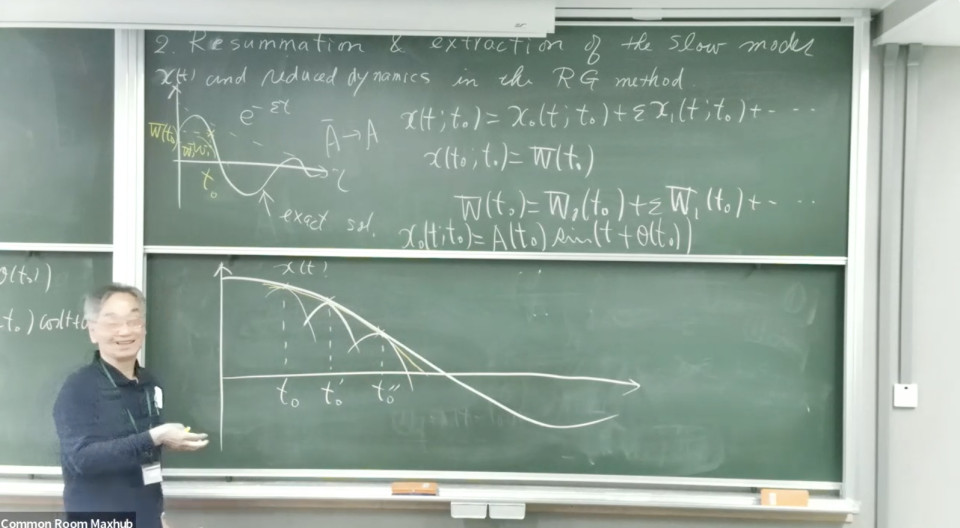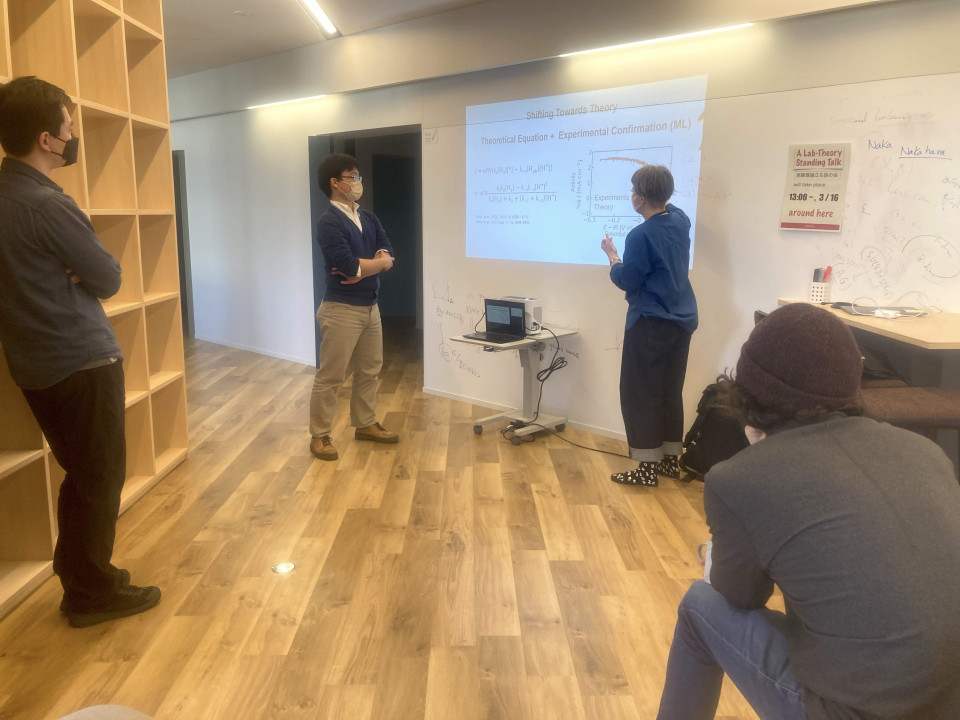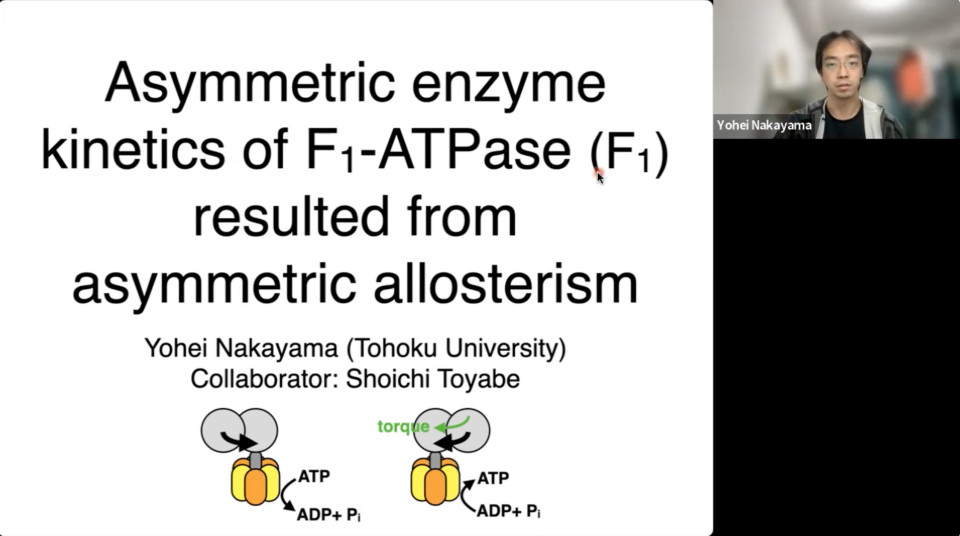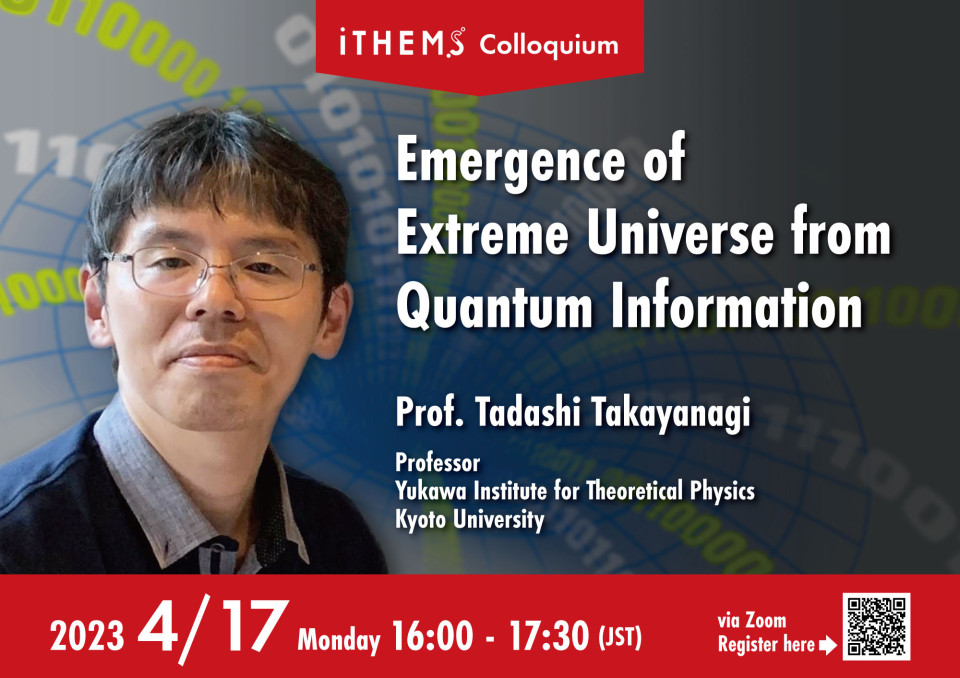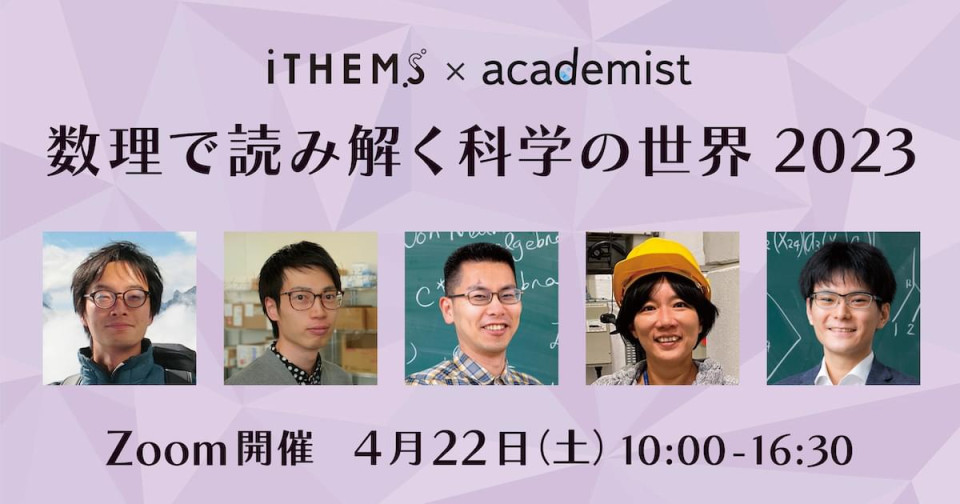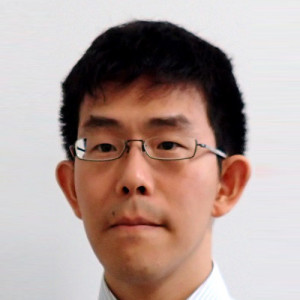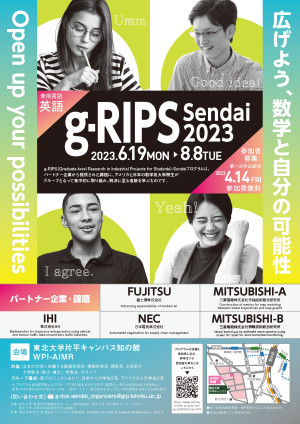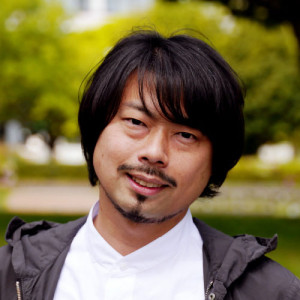Volume 246
Back to Newsletter List
Seminar Report
Seminar, "Introduction to the Renormalization group method as a powerful reduction method of dynamics" by Dr. Teiji Kunihiro on April 10, 2023
2023-04-13
In April 10, Dr Teiji Kunihiro (Prof Emeritus, Kyoto Univ) gave an introductory talk about the renormalization group method, entitled “Introduction to the Renormalization group method as a powerful reduction method of dynamics.”
In fact, this talk was the first seminar at our new seminar room #359 with the splendid black-board in RIKEN Wako Campus. The talk by Kunihiro-san using the black-board was very very clear, and we can understand the power of the Renormalization group method and its applicability [1]. The talk was also delivered via Zoom (i.e. ~35 participants in total), and there were lively discussions between the lecturer and the audience. After the talk, he kindly shared his lecture note with us so that we can take advantage of it. Thank you, Kunihiro-san for the wonderful talk!!
Reported by Gen Kurosawa
Reference
- T. Kunihiro, Y. Kikuchi, and K. Tsumura, Geometrical Formulation of Renormalization-Group Method as an Asymptotic Analysis: With Applications to Derivation of Causal Fluid Dynamics., Springer-Verlag (2022)
Introduction to the Renormalization group method as a powerful reduction method of dynamics
April 10 (Mon) 10:30 - 12:00, 2023
Seminar Report
Lab-Theory Standing Talks #1 by Dr. Hideshi Ooka on March 16, 2023
2023-04-11
The first Lab-Theory standing talk took place on March 16th, 2023, inviting Hideshi Ooka from CSRS (Riken Center for Sustainable Resource Science). He picked up the chemical process of making hydrogen from water as the subject. By design, the event is organized in a very informal setting."I was glad that the speaker prepared very few slides and all the slides were simple because it gave the audience an opportunity to ask many random questions in all sorts of direction," one of the participants, Catherine Beauchemin says. As she says, "in this light and flexible format, it is the audience that can decide what aspects are more interesting for them and ask more questions about it," there have been many questions asked and discussions followed. The event appears to be fruitful for the speaker too; "I will share the comment with my colleagues, as I believe it is a chance to advance the level of chemistry in our lab, " Hideshi Ooka concludes.
Reported by Tsukasa Tada
Lab-Theory Standing Talks #1
March 16 (Thu) 13:00 - 13:30, 2023
Seminar Report
iTHEMS Biology Seminar by Dr. Yohei Nakayama on March 30, 2023
2023-04-07
On March 30th, Dr. Nakayama talked about F1-ATPase from both experimental and theoretical aspects. In the introduction, he reviewed biological molecular motors and experimental facts. Then he introduced a Langevin model for the kinetics of F1 and explained how a specific case of the model fits the previous experiments. In the main part, he told us about new experimental results, relation to the theoretical model, and theoretical prediction based on the model. We thank Dr. Nakayama for giving us an exciting presentation.
Reported by Kyosuke Adachi
Asymmetric enzyme kinetics of F1-ATPase resulted from asymmetric allosterism
March 30 (Thu) 16:00 - 17:00, 2023
Upcoming Events
Colloquium
iTHEMS Colloquium
Emergence of Extreme Universe from Quantum Information
April 17 (Mon) 16:00 - 17:30, 2023
Tadashi Takayanagi (Professor, Yukawa Institute for Theoretical Physics, Kyoto University)
Recently, a new interpretation of gravitational spacetime in terms of quantum entanglement has been obtained. The idea of holography in string theory provides a simple geometric computation of entanglement entropy. This generalizes the well-known Bekenstein-Hawking formula of black hole entropy and strongly suggests that a gravitational spacetime consists of many qubits with quantum entanglement. Also a new progress on black hole information problem has been made recently by applying this idea. I will explain these developments in this colloquium.
Venue: via Zoom
Event Official Language: English
Seminar
ABBL-iTHEMS Joint Astro Seminar
Towards EeV Neutrino Astronomy with GRAND
April 18 (Tue) 14:00 - 15:15, 2023
Kumiko Kotera (Director of Research, Institute of Astrophysics, France)
We are living exciting times: we are now able to probe the most violent events of the Universe with diverse messengers (cosmic rays, neutrinos, photons and gravitational waves). One challenge to complete the multi-messenger picture resides in the highest energies, as no ultra-high energy neutrinos have been observed yet. This challenge could be undertaken by the GRAND (Giant Radio Array for Neutrino Detection) project, which aims at detecting ultra-high energy particles, with a colossal array of 200'000 antennas over 200'000 km2, split into ~20 sub-arrays of ~10'000 km2 deployed worldwide. In this talk, we will present preliminary designs and simulation results, plans for the ongoing, staged approach to construction, and the rich research program made possible by the proposed sensitivity and angular resolution.
Venue: Common Room #246-248, 2F Main Research Building, RIKEN / via Zoom
Event Official Language: English
Seminar
iTHEMS Biology Seminar
Machine learning predicts biological system evolution by gene gains and losses
April 20 (Thu) 16:00 - 17:00, 2023
Naoki Konno (Ph.D. Student, Department of Biological Sciences, Graduate School of Science, The University of Tokyo)
Prediction of evolution is a fundamental goal of biology with a potential impact on strategic pathogen control and genome engineering. While predictability of short-term and sequence-level evolution has been investigated, that of long-term and system-level evolution has not been systematically examined. Here, we show that evolution of metabolic systems by gene gains and losses is generally predictable by applying ancestral gene content reconstruction and machine learning techniques to ~3000 bacterial genomes. Our framework, Evodictor, successfully predicted gene gain and loss events at the branches of the reference phylogenetic tree, suggesting universally shared evolutionary pressures and constraints on metabolic systems. I herein present the mathematical model of Evodictor and our findings on evolutionary rules from physiological and ecological aspects. I will further discuss potential versatility of Evodictor approach to analyze various diversification processes along branching lineage trees, not only evolution, but also developmental processes.
Reference
- Naoki Konno and Wataru Iwasaki, Machine learning enables prediction of metabolic system evolution in bacteria, Science Advances (2023), doi: 10.1126/sciadv.adc9130
Venue: via Zoom
Event Official Language: English
Special Lecture
iTHEMS x academist Online Event "World of Mathematical Sciences 2023"
April 22 (Sat) 10:00 - 16:30, 2023
Takumi Doi (Senior Research Scientist, RIKEN Interdisciplinary Theoretical and Mathematical Sciences Program (iTHEMS))
Ryo Namba (Senior Research Scientist, RIKEN Interdisciplinary Theoretical and Mathematical Sciences Program (iTHEMS))
Yuto Moriwaki (Special Postdoctoral Researcher, RIKEN Interdisciplinary Theoretical and Mathematical Sciences Program (iTHEMS))
Kyosuke Adachi (Special Postdoctoral Researcher, Nonequilibrium Physics of Living Matter RIKEN Hakubi Research Team, RIKEN Center for Biosystems Dynamics Research (BDR))
Natsuki Tomida (Specially Appointed Assistant Professor, Center for Science Adventure and Collaborative Research Advancement (SACRA), Graduate School of Science, Kyoto University)
Venue: via Zoom
Event Official Language: Japanese
Seminar
DMWG Seminar
Search for TeV-scale WIMP Dark Matter by observing Gamma rays around the Galactic Centre with the MAGIC telescopes and future prospects.
April 25 (Tue) 11:00 - 12:00, 2023
Tomohiro Inada (Shuimu Tsinghua Fellow, Department of Physics, National Tsinghua University, Beijin, China)
Line-like features in TeV γ rays constitute a “smoking gun” for TeV-scale particle dark matter and new physics. Probing the Galactic Centre region with ground-based Cherenkov telescopes enables the search for TeV spectral features in immediate association with a dense dark matter reservoir at a sensitivity out of reach for satellite γ-ray detectors, and direct detection and collider experiments. I will report on about seven years of observations of the Galactic Centre region with the MAGIC stereoscopic telescope system reaching γ-ray energies up to 100 TeV. We constrain the cross-section for dark matter annihilation into two photons, achieving the best limits to date for a dark matter mass above 20 TeV and a cuspy dark matter profile at the Galactic Centre. I would like to discuss how to constrain supersymmetric wino models, which are one of the most popular dark matter candidates in the context of the Lightest Supersymmetric Particles (LSPs).
Venue: via Zoom
Event Official Language: English
Seminar
NEW WG Seminar
Quantum transport with cold atoms
May 10 (Wed) 13:30 - 15:00, 2023
Shun Uchino (Researcher, Advanced Science Research Center, Japan Atomic Energy Agency (JAEA))
Quantum transport occurring through a mesoscopic conduction region allows us to extract interesting quantum many-body phenomena. For decades, solid-state systems have been the playground of such transport and revealed nontrivial outcomes such as the conductance quantization in a quantum point contact system and the fractional charge measurement in a fractional quantum Hall system. More recently, cold atoms trapped in the vacuum have served as the complementary system to study the quantum transport phenomena.
In this seminar, I wish to discuss the recent progresses of quantum transport with cold atoms. The great advantages of those systems are that one can control quantum statistics, inter-particle interactions, dissipation, and dimensions. I try to show that such controllability enables to explore a regime of quantum transport that has yet to be reached with solid-state materials, including transport of bosons, dissipation effect in transport, and transport with synthetic dimensions.
Venue: Seminar Room #359, 3F Main Research Building, RIKEN / via Zoom
Event Official Language: English
Seminar
ABBL-iTHEMS Joint Astro Seminar
X-ray study on the synchrotron emission in Kepler's SNR
May 19 (Fri) 14:00 - 15:15, 2023
Vincenzo Sapienza (Ph.D. Student, Department of Physics, Graduate School of Science, The University of Tokyo)
Synchrotron X-ray emission in young supernova remnants (SNRs) is a powerful diagnostic tool to study the population of high energy electrons accelerated at the shock front.
We performed a spatially resolved spectral analysis of the young Kepler's SNR, where we identify two different regimes of particle acceleration.
In the north, where the shock interacts with a dense circumstellar medium (CSM), we found a more efficient acceleration than in the south, where the shock velocity is higher and there are no signs of shock interaction with dense CSM.
We also studied the temporal evolution of the synchrotron flux, from 2006 to 2014.
A number of regions show a steady synchrotron flux and equal cooling and acceleration times.
However, we found some regions where we measured a significant decrease in flux from 2006 to 2014.
Our results display a coherent picture of the different regimes of electron acceleration observed in Kepler's SNR.
Also If I will have time during the seminar it will be nice to present also some preliminary results I will have in the SN 1987A project.
Venue: Seminar Room #359, 3F Main Research Building, RIKEN / via Zoom
Event Official Language: English
Seminar
iTHEMS Theoretical Physics Seminar
Spectral correlations and scrambling dynamics in Sachdev-Ye-Kitaev type models
May 30 (Tue) 13:30 - 15:00, 2023
Masaki Tezuka (Assistant Professor, Division of Physics and Astronomy, Graduate School of Science, Kyoto University)
Note: Due to unexpected trouble, we have made the decision to postpone the seminar scheduled for February 21 to May 30. Sorry for the trouble.
Abstract:
The Sachdev-Ye-Kitaev (SYK) model, proposed in 2015, is a quantum mechanical model of N Majorana or complex fermions with all-to-all random four-body interactions. The model has attracted significant attention over the years due to its features such as the existence of the large-N solution with maximally chaotic behavior at low temperatures and holographic correspondence to low-dimensional gravity.
The sparse version of the SYK model reproduces essential features of the original model for reduced numbers of disorder parameters. We recently proposed [1] a further simplification, where we set the nonzero couplings to be +1 or -1 rather than sampling from a continuous distribution such as Gaussian. This binary-coupling model exhibits strong correlations in the spectrum, as observed in the spectral form factor, more efficiently in terms of the number of nonzero terms than in the Gaussian distribution case. We also discuss the scrambling dynamics with the binary-coupling sparse SYK model, comparing the model with the original model as well as the SYK model with random two-body terms [2], where the localization of the many-body eigenstates in the Fock space has been quantitatively studied [3,4].
References
- Masaki Tezuka, Onur Oktay, Enrico Rinaldi, Masanori Hanada, and Franco Nori, Binary-coupling sparse Sachdev-Ye-Kitaev model: An improved model of quantum chaos and holography, Phys. Rev. B 107, L081103 (2023), doi: 10.1103/PhysRevB.107.L081103, arXiv: 2208.12098
- Antonio M. García-García, Bruno Loureiro, Aurelio Romero-Bermúdez, and Masaki Tezuka, Chaotic-Integrable Transition in the Sachdev-Ye-Kitaev Model, Phys. Rev. Lett. 120, 241603 (2018), doi: 10.1103/PhysRevLett.120.241603
- Felipe Monteiro, Tobias Micklitz, Masaki Tezuka, and Alexander Altland, Minimal model of many-body localization, Phys. Rev. Research 3, 013023 (2021), doi: 10.1103/PhysRevResearch.3.013023
- Felipe Monteiro, Masaki Tezuka, Alexander Altland, David A. Huse, and Tobias Micklitz, Quantum Ergodicity in the Many-Body Localization Problem, Phys. Rev. Lett. 127, 030601 (2021), doi: 10.1103/PhysRevLett.127.030601, arXiv: 2012.07884
Venue: Hybrid Format (3F #359 and Zoom), Main Research Building, RIKEN Wako Campus
Event Official Language: English
School
Co-hosted by iTHEMS
g-RIPS-Sendai 2023
June 19 (Mon) - August 8 (Tue) 2023
The Research in Industrial Projects for Students (RIPS) program has been held at the Institute for Pure & Applied Mathematics (IPAM) of the University of California, Los Angeles. In 2018, the Advanced Institute for Materials Research (AIMR) at Tohoku University in Sendai launched the g-RIPS-Sendai program in collaboration with IPAM, targeting graduate-level students in mathematical science and related disciplines. Participants from the U.S. and Japan will work on cross-cultural teams on research projects designed by industrial partners. The projects are expected to be of great interest to the partners and offer stimulating challenges to students. For more information on this year's g-RIPS-Sendai 2023, please visit the program website at the related link.
Organizers:
Research Alliance Center for Mathematical Science (RACMaS), Tohoku University
Tohoku Forum for Creativity (TFC), Tohoku University
Advanced Institute for Materials Research (AIMR), Tohoku University
In cooperation with the following organizations:
RIKEN Interdisciplinary Theoretical and Mathematical Sciences Program (iTHEMS)
Institute for Pure & Applied Mathematics (IPAM), UCLA
Venue: Advanced Institute for Materials Research (AIMR), Tohoku University
Workshop
Supported by iTHEMS
6th Workshop on Virus Dynamics
July 4 (Tue) - 6 (Thu) 2023
Catherine Beauchemin (Deputy Program Director, RIKEN Interdisciplinary Theoretical and Mathematical Sciences Program (iTHEMS))
Shingo Iwami (Professor, Graduate School of Science, Nagoya University)
The Workshop on Virus Dynamics is an international meeting held every 2 years. It brings virologists, immunologists, and microbiologists together with mathematical and computational modellers, bioinformaticians, bioengineers, virophysicists, and systems biologists to discuss current approaches and challenges in modelling and analyzing different aspects of virus and immune system dynamics, and associated vaccines and therapeutics. This 6th version of the workshop builds on the success of previous ones held in Frankfurt (2013), Toronto (2015), Heidelberg (2017), Paris (2019) and virtually (2021). It is supported by the Interdisciplinary Theoretical and Mathematical Sciences (iTHEMS) program at RIKEN, by Nagoya University, and by the Japan Science and Technology Agency. Up-to-date information and registration is available via the website. The workshop is for in-person participation only (no virtual or hybrid option).
Venue: Noyori Conference Hall, Higashiyama Campus, Nagoya University
Event Official Language: English
Seminar
ABBL-iTHEMS Joint Astro Seminar
A dynamical model for IRAS 00500+6713: the remant of a type Iax supernova SN1181 hosting a double degenerate merger product WD J005311
July 7 (Fri) 14:00 - 15:15, 2023
Takatoshi Ko (Ph.D. Student, Research Center for the Early Universe (RESCEU), The University of Tokyo)
Iras 00500+6713 is a bright nebula in the infrared, and X-ray observations show it consists of diffuse region and strong illuminated central region. In addition, optical spectral observations have recently revealed that fast wind with about 15,000 km/s is blowing from the massive white dwarf at the center. The properties of this nebula and white dwarf are very similar to those theoretically predicted by the binary white dwarf merger. In addition, its position on the celestial sphere and the extent make it a prime candidate for the remnant of SN 1181, a historical supernova. In this study, we propose that such a multilayered structure is formed by the collision between the remnant of SN 1181 and the stellar wind blowing from the central white dwarf, and succeeded in constructing a model that is consistent with the multi-wavelength observations. The results show that the progenitor of SN 1181 is a binary white dwarf with 1.3-1.9 solar mass and that their merger triggered an explosion that ejected mass with 0.2-0.6 solar mass to form the present object. The extent of the X-ray source concentrated in the center reveals that these winds began blowing within the last 30 years, and we will discuss this property as well.
Venue: Seminar Room #359, 3F Main Research Building, RIKEN / via Zoom
Event Official Language: English
Lecture
Higher Algebra in Geometry
July 31 (Mon) - August 10 (Thu) 2023
Hiro Lee Tanaka (Assistant Professor, Department of Mathematics, Texas State University, USA)
In these lectures, we will shed light on modern tools of higher algebra, where the traditional structures of algebra yield themselves only after controlled deformations. We will introduce infinity-categories, spectra, operads, and other standard tools of the last decade. The main applications will be to encode various higher-algebraic structures that inevitably arise in, and shed light on, geometry and topology. If time permits, we will illustrate how spectra naturally arise in geometric invariants.
The audience is imagined to consist of mathematicians interested in applications of infinity-categorical tools -- so a broad range of geometers (including topologists) and algebraists. From Lecture Two onward, I will assume basic knowledge of algebraic topology (e.g., the material of Hatcher) and homological algebra.
These lectures will be held between July 31 and August 10, each from 10:30 to 12:00, for a total of 8 lectures.
1st Week: Jul 31(mon), Aug 1(tue) - 3(thu)
- Introduction to ideas of higher algebra in geometry, for a general audience.
- Introduction to infinity-categories and to spectra.
2nd Week: Aug 7(mon) - 10(thu)
- Examples in geometry and topology, including invariants of Legendrian links and generating functions.
- Future Directions.
Profile:
Hiro Lee Tanaka is an assistant professor in the Department of Mathematics. After receiving his Ph.D. from Northwestern University and completing postdoctoral work at Harvard University, he conducted research at the Mathematical Sciences Research Institute in Berkeley, California, and at the Isaac Newton Institute in Cambridge, England. His research aims to fuse the higher structures in modern algebra with geometries emerging from both classical mechanics and supersymmetric field theories. Beyond research, Tanaka engages in efforts to create more equitable and supportive environments throughout the mathematics community.
References
- Jacob Lurie, Higher Topos Theory (PDF 4.8MB), doi: 10.1515/9781400830558
- Jacob Lurie, Higher Algebra (PDF 6.9MB)
- Kerodon - an online resource for homotopy-coherent mathematics
- Jacob Lurie, Hiro Lee Tanaka, Associative algebras and broken lines, arXiv: 1805.09587
- Jacob Lurie, On the Classification of Topological Field Theories, arXiv: 0905.0465
- Oleg Lazarev, Zachary Sylvan, Hiro Lee Tanaka, The infinity-category of stabilized Liouville sectors, arXiv: 2110.11754
- Araminta Amabel, Artem Kalmykov, Lukas Müller, Hiro Lee Tanaka, Lectures on Factorization Homology, Infinity-Categories, and Topological Field Theories, arXiv: 1907.00066
- David Ayala, John Francis, Hiro Lee Tanaka, Factorization homology of stratified spaces, arXiv: 1409.0848
- David Nadler, Hiro Lee Tanaka, A stable infinity-category of Lagrangian cobordisms, arXiv: 1109.4835
- David Gepner, An Introduction to Higher Categorical Algebra, arXiv: 1907.02904
Venue: #435-437, Main Research Building, RIKEN Wako Campus / via Zoom
Event Official Language: English
Person of the Week
Self-introduction: Seishiro Ono
2023-04-10
My name is Seishiro Ono. I received my Ph.D. from the University of Tokyo in March 2023, and then I joined RIKEN iTHEMS in April 2023. My research interests lie in quantum condensed matter physics. I have been fascinated by the diversity of this field, and I am eager to understand the various phenomena from a unified point of view. I am currently investigating a unified understanding of superconductivity based on symmetry and topology. In addition, I have recently become interested in experimental signatures of topological nature, applications of machine learning to materials science, and quantum simulation of strongly correlated systems.
Paper of the Week
Week 3, April 2023
2023-04-13
Title: Observing Supernova Neutrino Light Curves with Super-Kamiokande. IV. Development of SPECIAL BLEND: a New Public Analysis Code for Supernova Neutrinos
Author: Akira Harada, Yudai Suwa, Masayuki Harada, Yusuke Koshio, Masamitsu Mori, Fumi Nakanishi, Ken'ichiro Nakazato, Kohsuke Sumiyoshi, Roger A. Wendell
arXiv: http://arxiv.org/abs/2304.05437v1
Title: From diffeomorphisms to exotic phenomena in small 4-manifolds
Author: Hokuto Konno, Abhishek Mallick, Masaki Taniguchi
arXiv: http://arxiv.org/abs/2304.05997v1
Title: Gamma-Ray Emission in the Seyfert Galaxy NGC 4151: Investigating the Role of Jet and Coronal Activities
Author: Yoshiyuki Inoue, Dmitry Khangulyan
arXiv: http://arxiv.org/abs/2304.04138v1
If you would like to cancel your subscription or change your email address,
please let us know via our contact form.
Copyright © iTHEMS, RIKEN. All rights reserved.


